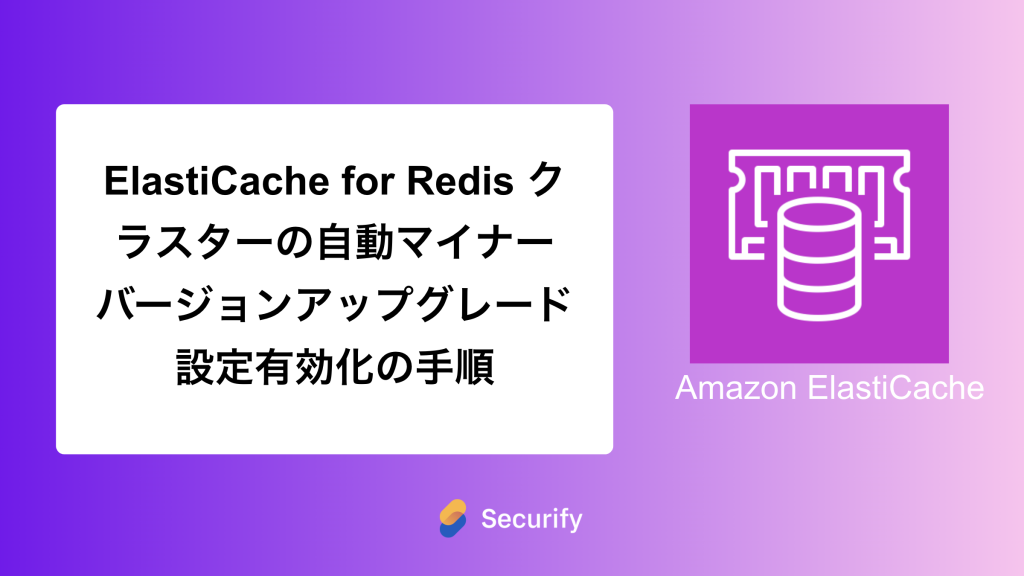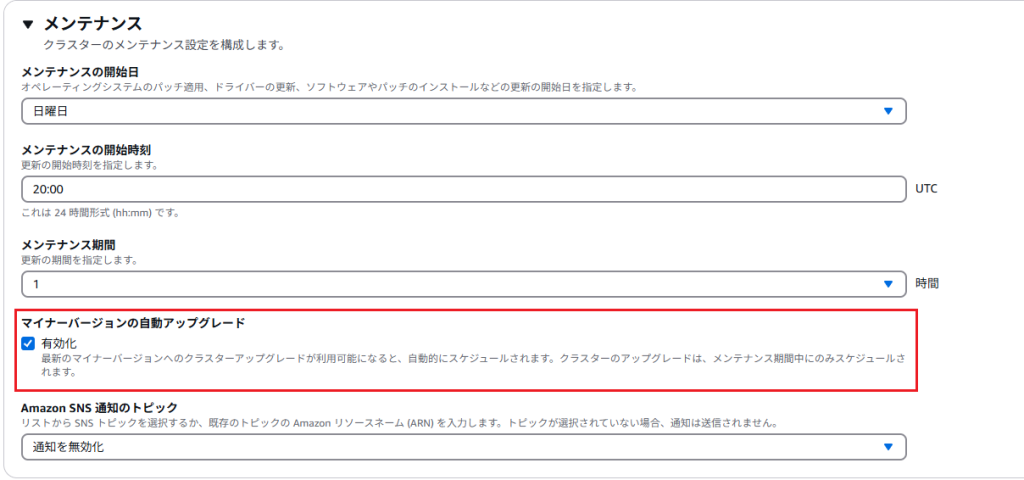ElastiCache for Redis クラスターの自動マイナーバージョンアップグレード設定有効化の手順

このブログシリーズ 「クラウドセキュリティ 実践集」 では、一般的なセキュリティ課題を取り上げ、「なぜ危険なのか?」 というリスクの解説から、「どうやって直すのか?」 という具体的な修復手順(コンソール、AWS CLI、Terraformなど)まで、分かりやすく解説します。
この記事では、Security Hubで検出された「[ElastiCache.2] ElastiCache クラスターでは、マイナーバージョンの自動アップグレードを有効にする必要があります」というセキュリティ課題の修正方法について解説します。

ポリシーの説明
[ElastiCache.2] ElastiCache クラスターでは、マイナーバージョンの自動アップグレードを有効にする必要があります
ElastiCache の Security Hub コントロール – AWS Security Hub
このコントロールは、Amazon ElastiCache がキャッシュクラスターにマイナーバージョンアップグレードを自動的に適用するかどうかを評価します。キャッシュクラスターにマイナーバージョンアップグレードが自動的に適用されていない場合、コントロールは失敗します。
ElastiCacheは、頻繁にセキュリティアップデートやパフォーマンス改善を含むマイナーバージョンをリリースします。自動アップグレードを有効にすることで、これらの重要な修正を自動的に適用し、手動でのメンテナンス作業を減らしつつ、クラスターのセキュリティと安定性を維持できます。
修復方法
AWSコンソールでの修正手順
- ElastiCache > Redis OSS キャッシュに移動します。
- 対象のキャッシュ名を選択後、「アクション」から変更を選択
- メンテナンスの項目でマイナーバージョンの自動アップグレードの「有効化」にチェックする
- チェック後、変更をプレビューで変更内容に問題ければ「変更する」を選択


Terraformでの修復手順
ElastiCache for Redisクラスターの自動マイナーバージョンアップグレードを有効にするためのTerraformコードと、重要な修正ポイントを説明します。
# KMS key for encryption
resource "aws_kms_key" "elasticache" {
description = "KMS key for ElastiCache encryption"
deletion_window_in_days = 7
enable_key_rotation = true
policy = jsonencode({
Version = "2012-10-17"
Statement = [
{
Sid = "Enable IAM User Permissions"
Effect = "Allow"
Principal = {
AWS = "arn:aws:iam::${data.aws_caller_identity.current.account_id}:root"
}
Action = "kms:*"
Resource = "*"
},
{
Sid = "Allow ElastiCache to use the key"
Effect = "Allow"
Principal = {
Service = "elasticache.amazonaws.com"
}
Action = [
"kms:Decrypt",
"kms:GenerateDataKey",
"kms:CreateGrant"
]
Resource = "*"
}
]
})
tags = var.tags
}
# Subnet group for Redis
resource "aws_elasticache_subnet_group" "redis" {
name = "redis-${var.environment}"
description = "Subnet group for Redis cluster"
subnet_ids = var.private_subnet_ids
tags = var.tags
}
# Parameter group for Redis
resource "aws_elasticache_parameter_group" "redis" {
family = "redis6.x" # 例: "6.2" などメジャー.マイナーを固定し、パッチだけ自動更新
name = "redis-params-${var.environment}"
parameter {
name = "maxmemory-policy"
value = "volatile-ttl"
}
tags = var.tags
}
# Security group for Redis
resource "aws_security_group" "redis" {
name = "redis-${var.environment}"
description = "Security group for Redis cluster"
vpc_id = var.vpc_id
ingress {
description = "Redis from application security groups"
from_port = 6379
to_port = 6379
protocol = "tcp"
security_groups = var.allowed_security_group_ids
}
egress {
from_port = 0
to_port = 0
protocol = "-1"
cidr_blocks = ["0.0.0.0/0"]
}
tags = merge(var.tags, {
Name = "redis-${var.environment}"
})
}
# ★重要: Redis replication group with auto minor version upgrade
resource "aws_elasticache_replication_group" "redis" {
replication_group_id = "redis-${var.environment}"
replication_group_description = "Redis cluster for ${var.environment}"
node_type = var.node_type
port = 6379
# ★重要: バージョン設定
engine = "redis"
engine_version = var.engine_version
# ★重要: 自動マイナーバージョンアップグレードの有効化
auto_minor_version_upgrade = true
# ★重要: メンテナンス設定
maintenance_window = "mon:03:00-mon:04:00"
notification_topic_arn = var.sns_topic_arn
parameter_group_name = aws_elasticache_parameter_group.redis.name
subnet_group_name = aws_elasticache_subnet_group.redis.name
security_group_ids = [aws_security_group.redis.id]
# 暗号化設定
at_rest_encryption_enabled = true
transit_encryption_enabled = true
kms_key_id = aws_kms_key.elasticache.arn
auth_token = var.auth_token
# クラスター設定
num_cache_clusters = var.number_of_nodes
automatic_failover_enabled = true
multi_az_enabled = true
# バックアップ設定
snapshot_retention_limit = 7
snapshot_window = "02:00-03:00"
tags = var.tags
}
# Variables
variable "environment" {
description = "Environment name"
type = string
}
variable "vpc_id" {
description = "VPC ID"
type = string
}
variable "private_subnet_ids" {
description = "List of private subnet IDs"
type = list(string)
}
variable "allowed_security_group_ids" {
description = "List of security group IDs allowed to access Redis"
type = list(string)
}
variable "node_type" {
description = "ElastiCache node type"
type = string
default = "cache.t3.medium"
}
variable "engine_version" {
description = "Redis engine version"
type = string
default = "6.x" # 最新の安定バージョンを使用
}
variable "number_of_nodes" {
description = "Number of cache nodes"
type = number
default = 2
}
variable "auth_token" {
description = "Auth token for Redis authentication"
type = string
sensitive = true
}
variable "sns_topic_arn" {
description = "SNS topic ARN for notifications"
type = string
}
variable "tags" {
description = "Tags for resources"
type = map(string)
default = {}
}
# Data sources
data "aws_caller_identity" "current" {}
主要な修正ポイントは以下の通りです:
- 自動マイナーバージョンアップグレードの有効化(最重要):
resource "aws_elasticache_replication_group" "redis" {
# この設定が最も重要
auto_minor_version_upgrade = true
}
エンジンバージョンとメンテナンス設定:
# バージョン設定
engine_version = "6.x" # 最新の安定バージョンを使用
# メンテナンス設定
maintenance_window = "mon:03:00-mon:04:00"
notification_topic_arn = var.sns_topic_arn
この設定により:
- 自動マイナーバージョンアップグレード
- セキュリティパッチの自動適用
- バージョン更新の通知
- バックアップと復旧の確保
が実現されます。
注意:
- メンテナンスウィンドウはアプリケーションの低負荷時間帯に設定
- クラスターモード有効 (sharding) の場合、自動マイナーアップグレードは現状適用されません。バージョン管理は手動で行ってください
- 自動アップグレード前にテスト環境での検証を推奨
- バージョンアップグレードの影響を考慮したアプリケーション設計が必要
最後に
今回は、ElastiCacheクラスターまたはレプリケーショングループでマイナーバージョンの自動アップグレードを有効にする方法についてご紹介しました。自動アップグレードを有効にすることで、セキュリティリスクを低減し、クラスターの安定性を向上させることができます。
この問題の検出は弊社が提供するSecurifyのCSPM機能で簡単に検出及び管理する事が可能です。
運用が非常に楽に出来る製品になっていますので、ぜひ興味がある方はお問い合わせお待ちしております。
最後までお読みいただきありがとうございました。この記事が皆さんの役に立てば幸いです。
CSPMについてはこちらで解説しております。併せてご覧ください。

